高考系列语法复习-- 基本句型[下学期]
文档属性
| 名称 | 高考系列语法复习-- 基本句型[下学期] |
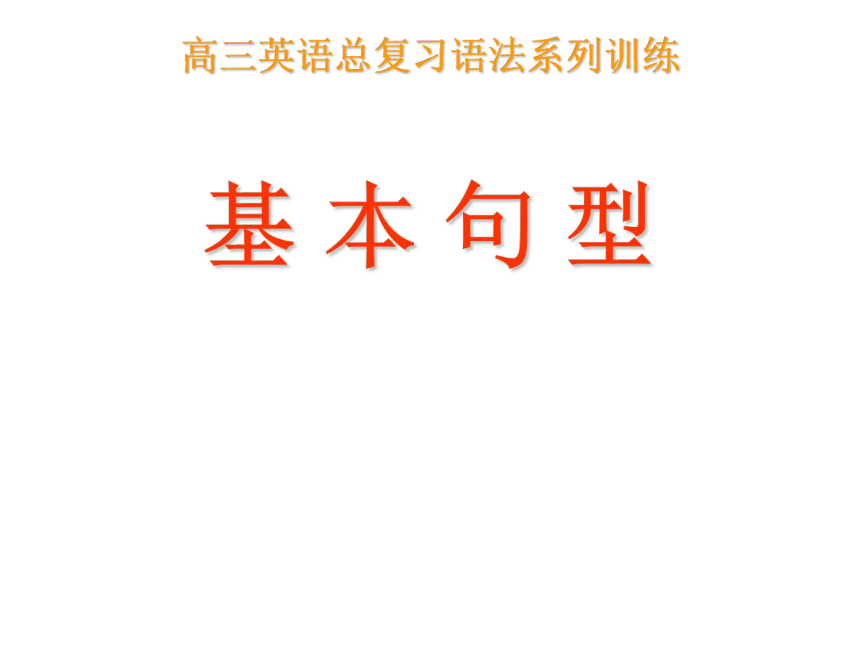
|
|
| 格式 | rar | ||
| 文件大小 | 463.9KB | ||
| 资源类型 | 教案 | ||
| 版本资源 | 通用版 | ||
| 科目 | 英语 | ||
| 更新时间 | 2006-03-16 08:36:00 | ||
图片预览

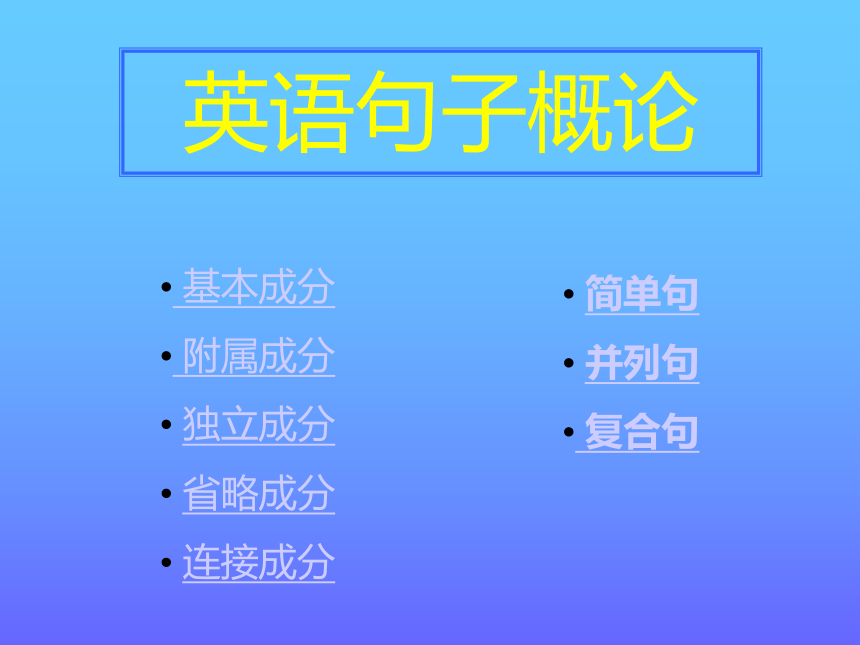


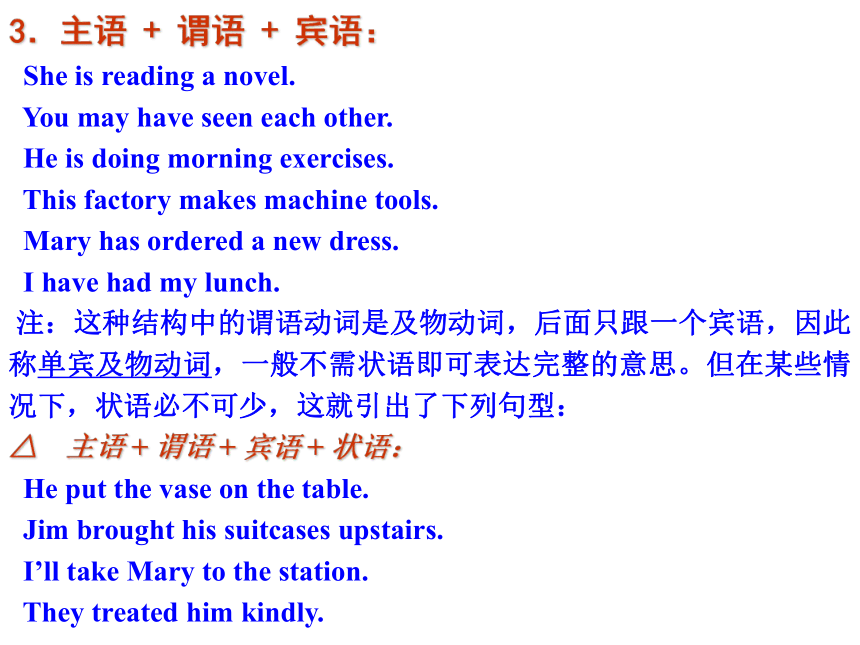
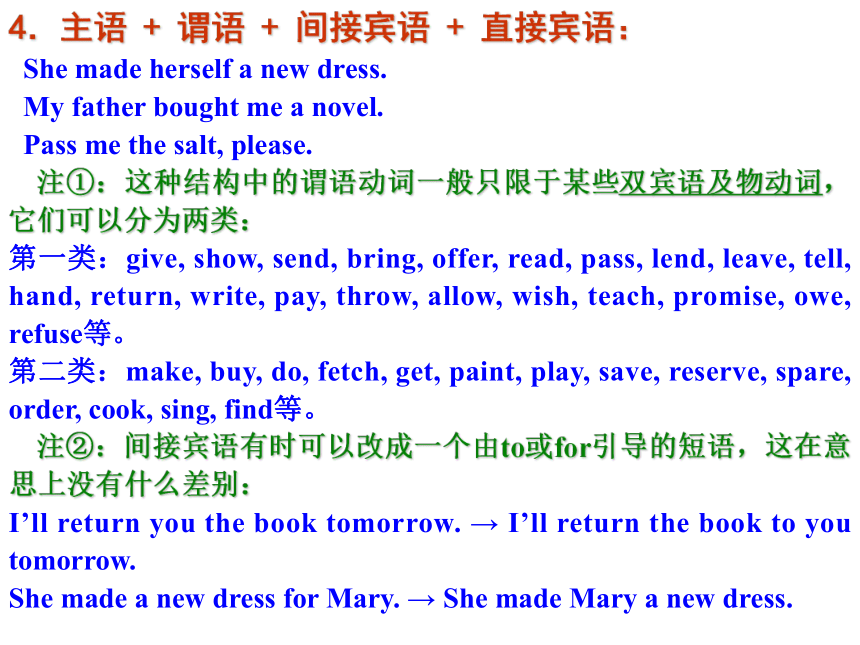
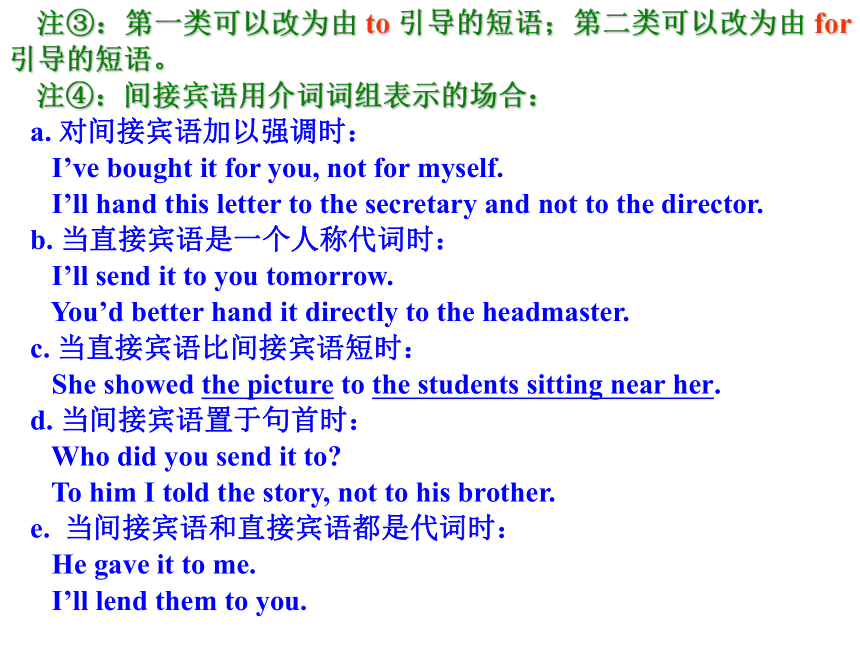

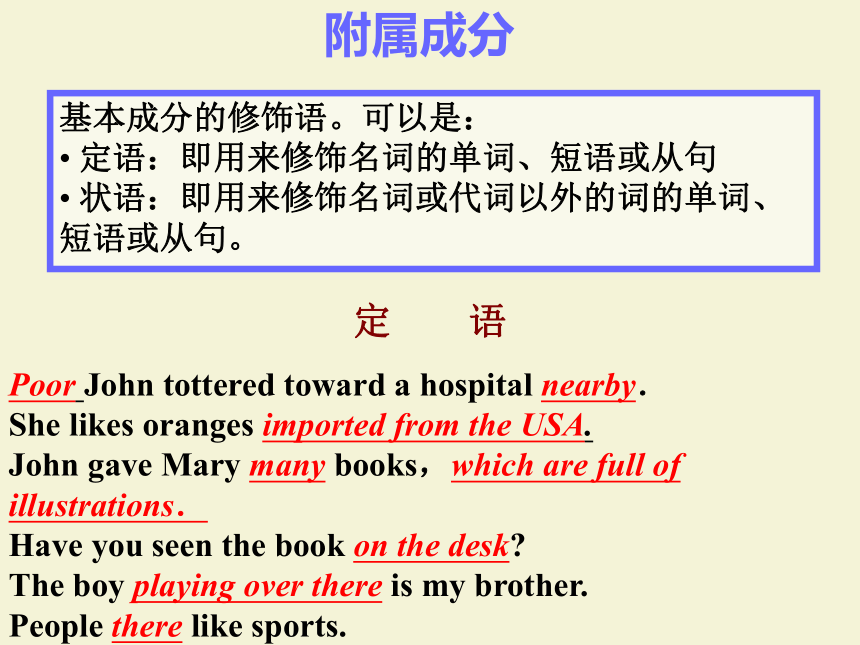

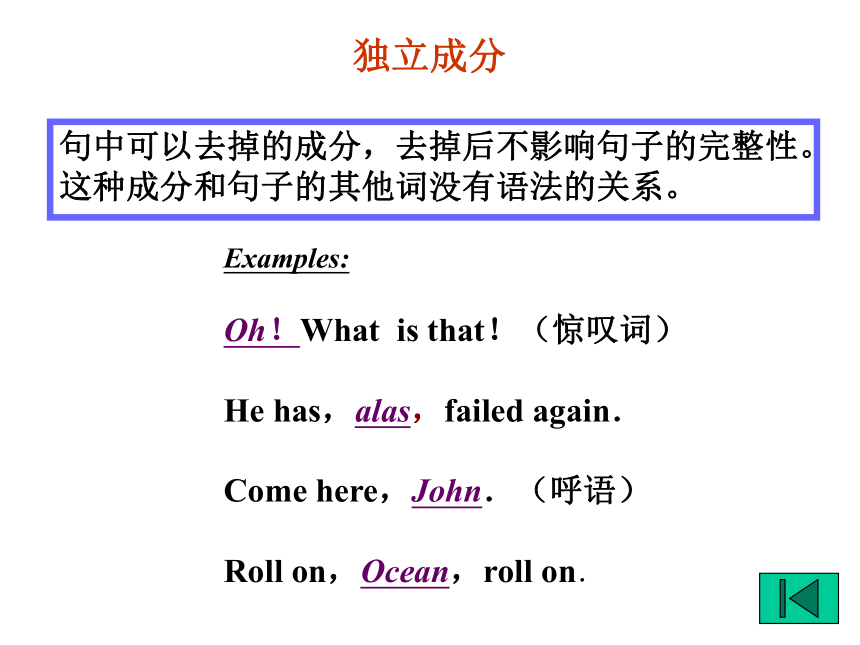
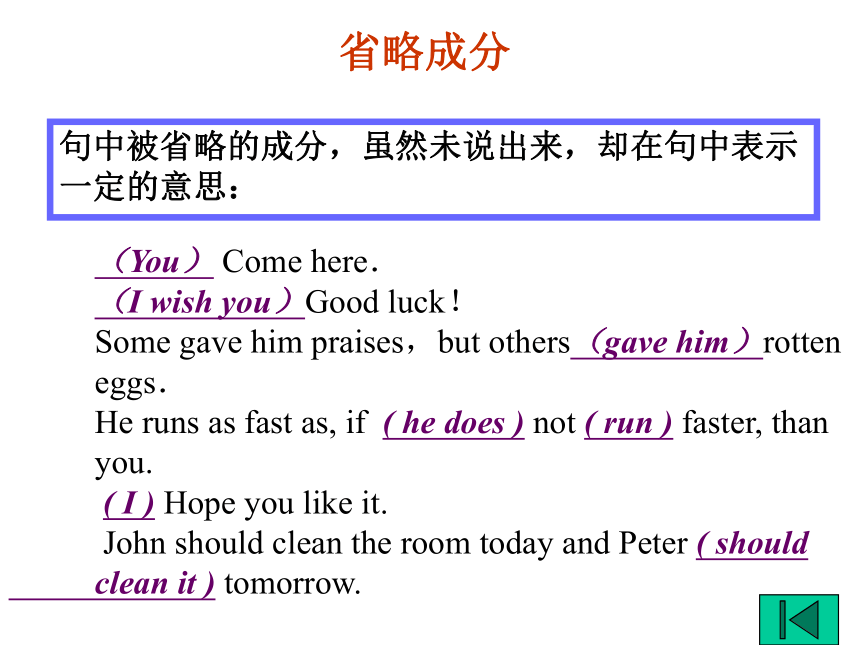
文档简介
课件36张PPT。高三英语总复习语法系列训练基 本 句 型英语句子概论 基本成分
附属成分
独立成分
省略成分
连接成分 简单句
并列句
复合句 主语 + 不及物动词 ( S + Vi )
主语 + 及物动词 +宾语 ( S + Vt + O)
主语 + 系动词 + 表 (S + LV + predicative)
主语+双宾动词+间宾+直宾(S +Vt +O.indir+O. dir)
主语 + 宾补动词 +宾语 +宾语补语
(S + Vt. + O + O. compl)
There + be / stand/ lie / live...简单句的五种基本句型主语、动词(不及物动词、及物动词、双宾动词、系动词、宾补动词)、宾语及补语可以称为基本句子成分。
完整的句子一般至少包含2个基本成分,至多4个基本成分。1.主语 + 系动词 + 表语:
A foreign language is a weapon in the struggle of life.
The plan sounds perfect.
This material feels soft.
This is where I work.
2.主语 + 谓语:
The telephone rang.
His father might have died.
We all breathe, drink and eat.
注:这种结构中的谓语动词是不及物动词,状语并非结构上不可缺少的成分。但在某种情况下,不加状语便不能表达完整的意思,这就引出了下列句型:
△??? 主语 + 谓语 + 状语:
The meeting lasted for two hours.
We walked for five miles.
This box weighs five kilos.
He lives in Guangzhou.
They will be flying to London.3.主语 + 谓语 + 宾语:
She is reading a novel.
You may have seen each other.
He is doing morning exercises.
This factory makes machine tools.
Mary has ordered a new dress.
I have had my lunch.
注:这种结构中的谓语动词是及物动词,后面只跟一个宾语,因此称单宾及物动词,一般不需状语即可表达完整的意思。但在某些情况下,状语必不可少,这就引出了下列句型:
△??? 主语 + 谓语 + 宾语 + 状语:
He put the vase on the table.
Jim brought his suitcases upstairs.
I’ll take Mary to the station.
They treated him kindly.4.主语 + 谓语 + 间接宾语 + 直接宾语:
She made herself a new dress.
My father bought me a novel.
Pass me the salt, please.
注①:这种结构中的谓语动词一般只限于某些双宾语及物动词,它们可以分为两类:
第一类:give, show, send, bring, offer, read, pass, lend, leave, tell, hand, return, write, pay, throw, allow, wish, teach, promise, owe, refuse等。
第二类:make, buy, do, fetch, get, paint, play, save, reserve, spare, order, cook, sing, find等。
注②:间接宾语有时可以改成一个由to或for引导的短语,这在意思上没有什么差别:
I’ll return you the book tomorrow. → I’ll return the book to you tomorrow.
She made a new dress for Mary. → She made Mary a new dress. 注③:第一类可以改为由 to 引导的短语;第二类可以改为由 for引导的短语。
注④:间接宾语用介词词组表示的场合:
a. 对间接宾语加以强调时:
I’ve bought it for you, not for myself.
I’ll hand this letter to the secretary and not to the director.
b. 当直接宾语是一个人称代词时:
I’ll send it to you tomorrow.
You’d better hand it directly to the headmaster.
c. 当直接宾语比间接宾语短时:
She showed the picture to the students sitting near her.
d. 当间接宾语置于句首时:
Who did you send it to?
To him I told the story, not to his brother.
e. 当间接宾语和直接宾语都是代词时:
He gave it to me.
I’ll lend them to you.5.主语 + 谓语 + 宾语 + 宾语补足语:
We have proved him wrong.
What make you think so?
She found the child fast asleep.
I called him a fool.
注:这种结构中的谓语动词一般只限于某些复合宾语及物动词。附属成分基本成分的修饰语。可以是:
定语:即用来修饰名词的单词、短语或从句
状语:即用来修饰名词或代词以外的词的单词、短语或从句。定 语
Poor John tottered toward a hospital nearby.
She likes oranges imported from the USA.
John gave Mary many books,which are full of illustrations.
Have you seen the book on the desk?
The boy playing over there is my brother.
People there like sports.John often came to chat with me.
John likes oranges very much.
Whenever he gets drunk,John makes Mary very angry.
Hearing the news, he jumped with joy.
As he was ill, he didn’t come to class yesterday.
She is sitting at the desk, doing her homework.
My father worked in this school ten years ago.
You’d better stay here.状 语Examples:
Oh!What is that!(惊叹词)
He has,alas,failed again.
Come here,John.(呼语)
Roll on,Ocean,roll on.句中可以去掉的成分,去掉后不影响句子的完整性。这种成分和句子的其他词没有语法的关系。独立成分 (You) Come here.
(I wish you)Good luck!
Some gave him praises,but others(gave him)rotten eggs.
He runs as fast as, if ( he does ) not ( run ) faster, than you.
( I ) Hope you like it.
John should clean the room today and Peter ( should clean it ) tomorrow.
句中被省略的成分,虽然未说出来,却在句中表示一定的意思:省略成分连接成分实际上是一个连词,用来连接两个或几个平行的词、短语和分句。这种连词叫做并列连词。
另一类连接成分是用来连接两个句子、且一个句子从属于另一个句子(即从句)的连词。这类连词叫从属连词。从属连词主要用于引导各种从句。
一个完整的句子(主句或从句)必须包含2个到4个基本成分,此外,如果意思上有需要,还可包含一个或更多其他的句子成分。连接成分简单句简单句只有一个限定动词(即只有一个主谓结构),它是最小的句子单位。主要起下列四种作用中的一种。
作一种陈述
提出一个问题
发出一种命令或请求
表示一种感叹Examples:
The boy hit the dog. / The dog bit the boy.
The girl read the books. / The books pleased the girl.
Stephen apologized at once.
Does the shop close at 7 tonight?
Shut the door.
What a slow train this is!简单句的基本词序主语 动词部分 宾语 状语
(谓语) 方式 地点 时间
I bought a hat yesterday.
The children ran home.
The taxi driver shouted at me angrily.
We ate our meal in silence.
The car stopped suddenly.
A young girl walked confidently in the room.
They drove him away in a police car.简单句的扩展成份简单句的主语、宾语可以加上一个短语(如定语)来扩展,及物动词或不及物动词也可以与其它短语(如状语)连用进行扩展。
I bought a rain coat with a warm lining.
The dog jumped through the window.
He is saving up to buy a mobile phone.
A bright little boy with rosy cheeks put three bottles of milk quietly on my doorstep before seven o’clock.
He worked like a madman in the garden on Saturday.
The young girl with long black hair seems to be very happy.句 子 成 分一、主语 主语可以用下面这些东西表示:
1. 名词;2. 代词; 3. 数词;4. 动名词;5. 不定式;6. 词组或复合结构;7. 从句;8. 名词化的其他词类,如:
A foreign language is a weapon in the struggle of life.
Who is speaking, please? This is Jack speaking.
Two will be enough.
Living in that island country for three months was an unforgetable experience for me.
Early to bed and early to rise makes a man healthy, happy and wise.
Whether we’ll go depends on the weather.
“A” is an article.二、表语 表语可以用下面这些东西表示:
1. 名词;2. 代词;3. 数词;4. 形容词;5. 分词;6. 动名词;7. 不定式;8. 副词;9. 介词短语;10. 词组;11. 从句,如:
The masses are the real heroes.
That’s something we have always to keep in mind.
She was the first to learn about it.
My idea is this.
Time is pressing. Let’s hurry up.
All I could do was send him a telegram.
We must be off now.
They are twice the size of chickens.
My idea is that we should stick to our original plan.三、宾语 宾语可以用下面这些东西表示:
1. 名词;2. 代词;3. 数词;4. 动名词;5. 不定式;6. 复合结构;
7. 从句;8. 名词化的形容词及其他词类,如:
She died a heroic death.
They didn’t promise him anything definite.
How many do you want? We need two.
Pay attention to uniting and working with comrades who differ with you.
Learn to play the piano.
I’ll get it stamped.
Did you write down what she said? 四、定语 定语可以用下面这些东西表示:
1. 形容词;2. 代词;3. 数词;4. 名词或名词所有格;5. 分词;
6. 不定式;7. 介词短语;8. 副词;9. 词组或合成词;10. 从句,如:
His words moved everyone present.
We belong to the third world.
We must live up to the Party’s expectations.
This is indeed a most pressing problem.
There are two things to be discussed today.
the interests of the people / a man of good temper / a child of five五、状语 状语可以用下面这些东西表示:
1. 副词;2. 介词短语;3. 不定式;4. 分词;5. 形容词;6. 词组;
7. 复合结构;8. 从句,如:
They were greatly touched to hear the old man’s story. (副词)
They did everything they could to save the boy’s life. (不定式)
I said it in fun. (介词短语)
They all rushed over, eager to help. (形容词)
They returned tired and hungry. (形容词)
We are working day and night … . (词组)
He came up shouldering a spade. (分词)
We completed the work five days ahead of time. (词组)
Seeing this, some students became very worried. (分词)
He entered the room, his nose red with cold. (复合结构) 句 子 的 种 类一、? 陈述句:
She arrived quite early. (事实) / She may have arrived now. (看法)
二、疑问句:
1.一般疑问句:
Has the factory gone into production?
Shall I turn on the TV?
2.特殊疑问句:
Which colour do you prefer?
How much is this table-cloth?
3.选择疑问句:
①??? 一般疑问句 + or + 第二个选择:
Are you an Englishman or an American?
②??? 特殊疑问句 + 选择部分:
Which do you prefer, red wine or white?
4.反意(或附加)疑问句:
You are not going out today, are you? Yes, I am. / No, I’m not.三、祈使句:
Be sure to get here before nine.
You do it right now.
四、感叹句:
①??? what + 感叹句:
What a noble-hearted man he was!
What good news it is!
②??? how + 感叹句:
How well she dances!
How fast they are working!句 子 的 结 构 层 次一、简单句
二、并列句:
We love peace but we are not afraid of war.
Hurry up, it’s getting late.
三、复合句:
There is something in what he said.
That’s exactly what I am planning to do.
四、并列复合句并列句需把几个意思连接在一起时,可用分号或把两个或几个简单句用并列连词连接起来,这种结构即构成一个并列句。用分号:
We fished all day; we didn’t catch a thing.用分号,后跟一个连接副词:
We fished all day; however, we didn’t catch a thing.用并列连词(如and、but、so、yet等)
We fished all day, but (we) didn’t catch a thing.并列句常用并列连词 coordinating conjunctions
平行并列连词:
转折并列连词:
因果并列连词:
选择并列连词:and, both…and, not only…but also, neither…nor, and thenbut, however, while, yetfor, soor, either…or, neither… nor并列句并列句的词序:并列句基本上保留了简单句的词序。主语 谓语 宾语 连词 主语 动词 表语
Jimmy fell off his bike but (he) wasn’t hurt.五种简单句型可用并列连词连接起来组成并列句。 主 谓 状(方式) 连 主 谓 表
Frank worked hard and (he ) became an architect.
主 谓 宾 连 主 谓 地点
I ’ve got a cold, so I ’m going to bed.
主 谓 宾 宾补 连 主 谓 宾
They made him chairman, but (they) didn’t increase his salary.Exercise:
请用合适的并列连词把每组句子合并为一个并列句。He was tired, so he went to bed.1. He was tired. He went to bed. 2. The child hid behind his mother's skirt. He was afraid of the dog.3. He made a promise. He didn’t keep it.He made a promise, but He didn’t keep it. The child hid behind his mother's skirt, for he was afraid of the dog.由一个主句和一个或者一个以上从句所
构成的句子。在英语书面语中应用广泛。
主句是一个完整的句子,它可以独立存在。
从句是一个不完整的句子,它必须和一个
主句连用,不能独立存在。
复合句可以通过把两个以上简单句连接
在一起构成,但复合句的各组成部份并非
同等重要,其中一个句子由从属连词引
导(从句),用以修饰另一句子(主句)。
复合句 = 主句 + 从句复合句复合句是在简单句的基础上,通过从属连词将两个或两个以上简单句连接在一起而构成。从属连词所引导的从句起形容词、名词、副词的作用。复合句主要包含以下类型从句:
1. 主语从句 2. 宾语从句
3. 表语从句 4. 定语从句
5. 状语从句 6. 同位语从句 英文写作中最常使用的从句
宾语从句
状语从句
定语从句复合句与简单句:复合句 = 简单句 + 从属连词 +简单句He told me the news.that the match had
been cancelled.宾语how much he was prepared
to pay for my car.that I could have the
money without delay.how much he was prepared to
pay for my car and that I could
have the money without delay. when he was
leaving for Paris.that his fathered
was working in
that school.宾语从句复合句与简单句:复合句 = 简单句 + 从属连词 +简单句I don’t knowhim.He has finished his work that he has finished his work.
whether he has finished his work.宾语从句He is leaving for Washington.that he is leaving for Washington.
when he is leaving for Washington.
why he is leaving for Washington.
how he is leaving for Washington.
whether he is leaving for Washington.复合句与简单句:复合句 = 简单句 + 从属连词 +简单句the people surprised That What he said
what he did主语That he didn’t
know the answerin the room.定语who were sitting in the room.
who were present.
whose sons were at war.
who had signed the contract.复合句与简单句:复合句 = 简单句 + 从属连词 +简单句That is the fact.表 语what he needs.
what he gave me.
why he was late.
because he was ill.
what has happened.复合句与简单句:复合句 = 简单句 + 从属连词 +简单句He worked in that factorythree years ago.地点状语时间状语where his
father workedin that factorywhere I livedwhen he
lived thereHis father worked there.I lived there.He lived there
three years ago.复合句与简单句:复合句 = 简单句 + 从属连词 +简单句Put the book on the desk.where you took it.where it was.地点状语where you found it.You can’t camp here.where there are
a lot of trees.wherever you like.
附属成分
独立成分
省略成分
连接成分 简单句
并列句
复合句 主语 + 不及物动词 ( S + Vi )
主语 + 及物动词 +宾语 ( S + Vt + O)
主语 + 系动词 + 表 (S + LV + predicative)
主语+双宾动词+间宾+直宾(S +Vt +O.indir+O. dir)
主语 + 宾补动词 +宾语 +宾语补语
(S + Vt. + O + O. compl)
There + be / stand/ lie / live...简单句的五种基本句型主语、动词(不及物动词、及物动词、双宾动词、系动词、宾补动词)、宾语及补语可以称为基本句子成分。
完整的句子一般至少包含2个基本成分,至多4个基本成分。1.主语 + 系动词 + 表语:
A foreign language is a weapon in the struggle of life.
The plan sounds perfect.
This material feels soft.
This is where I work.
2.主语 + 谓语:
The telephone rang.
His father might have died.
We all breathe, drink and eat.
注:这种结构中的谓语动词是不及物动词,状语并非结构上不可缺少的成分。但在某种情况下,不加状语便不能表达完整的意思,这就引出了下列句型:
△??? 主语 + 谓语 + 状语:
The meeting lasted for two hours.
We walked for five miles.
This box weighs five kilos.
He lives in Guangzhou.
They will be flying to London.3.主语 + 谓语 + 宾语:
She is reading a novel.
You may have seen each other.
He is doing morning exercises.
This factory makes machine tools.
Mary has ordered a new dress.
I have had my lunch.
注:这种结构中的谓语动词是及物动词,后面只跟一个宾语,因此称单宾及物动词,一般不需状语即可表达完整的意思。但在某些情况下,状语必不可少,这就引出了下列句型:
△??? 主语 + 谓语 + 宾语 + 状语:
He put the vase on the table.
Jim brought his suitcases upstairs.
I’ll take Mary to the station.
They treated him kindly.4.主语 + 谓语 + 间接宾语 + 直接宾语:
She made herself a new dress.
My father bought me a novel.
Pass me the salt, please.
注①:这种结构中的谓语动词一般只限于某些双宾语及物动词,它们可以分为两类:
第一类:give, show, send, bring, offer, read, pass, lend, leave, tell, hand, return, write, pay, throw, allow, wish, teach, promise, owe, refuse等。
第二类:make, buy, do, fetch, get, paint, play, save, reserve, spare, order, cook, sing, find等。
注②:间接宾语有时可以改成一个由to或for引导的短语,这在意思上没有什么差别:
I’ll return you the book tomorrow. → I’ll return the book to you tomorrow.
She made a new dress for Mary. → She made Mary a new dress. 注③:第一类可以改为由 to 引导的短语;第二类可以改为由 for引导的短语。
注④:间接宾语用介词词组表示的场合:
a. 对间接宾语加以强调时:
I’ve bought it for you, not for myself.
I’ll hand this letter to the secretary and not to the director.
b. 当直接宾语是一个人称代词时:
I’ll send it to you tomorrow.
You’d better hand it directly to the headmaster.
c. 当直接宾语比间接宾语短时:
She showed the picture to the students sitting near her.
d. 当间接宾语置于句首时:
Who did you send it to?
To him I told the story, not to his brother.
e. 当间接宾语和直接宾语都是代词时:
He gave it to me.
I’ll lend them to you.5.主语 + 谓语 + 宾语 + 宾语补足语:
We have proved him wrong.
What make you think so?
She found the child fast asleep.
I called him a fool.
注:这种结构中的谓语动词一般只限于某些复合宾语及物动词。附属成分基本成分的修饰语。可以是:
定语:即用来修饰名词的单词、短语或从句
状语:即用来修饰名词或代词以外的词的单词、短语或从句。定 语
Poor John tottered toward a hospital nearby.
She likes oranges imported from the USA.
John gave Mary many books,which are full of illustrations.
Have you seen the book on the desk?
The boy playing over there is my brother.
People there like sports.John often came to chat with me.
John likes oranges very much.
Whenever he gets drunk,John makes Mary very angry.
Hearing the news, he jumped with joy.
As he was ill, he didn’t come to class yesterday.
She is sitting at the desk, doing her homework.
My father worked in this school ten years ago.
You’d better stay here.状 语Examples:
Oh!What is that!(惊叹词)
He has,alas,failed again.
Come here,John.(呼语)
Roll on,Ocean,roll on.句中可以去掉的成分,去掉后不影响句子的完整性。这种成分和句子的其他词没有语法的关系。独立成分 (You) Come here.
(I wish you)Good luck!
Some gave him praises,but others(gave him)rotten eggs.
He runs as fast as, if ( he does ) not ( run ) faster, than you.
( I ) Hope you like it.
John should clean the room today and Peter ( should clean it ) tomorrow.
句中被省略的成分,虽然未说出来,却在句中表示一定的意思:省略成分连接成分实际上是一个连词,用来连接两个或几个平行的词、短语和分句。这种连词叫做并列连词。
另一类连接成分是用来连接两个句子、且一个句子从属于另一个句子(即从句)的连词。这类连词叫从属连词。从属连词主要用于引导各种从句。
一个完整的句子(主句或从句)必须包含2个到4个基本成分,此外,如果意思上有需要,还可包含一个或更多其他的句子成分。连接成分简单句简单句只有一个限定动词(即只有一个主谓结构),它是最小的句子单位。主要起下列四种作用中的一种。
作一种陈述
提出一个问题
发出一种命令或请求
表示一种感叹Examples:
The boy hit the dog. / The dog bit the boy.
The girl read the books. / The books pleased the girl.
Stephen apologized at once.
Does the shop close at 7 tonight?
Shut the door.
What a slow train this is!简单句的基本词序主语 动词部分 宾语 状语
(谓语) 方式 地点 时间
I bought a hat yesterday.
The children ran home.
The taxi driver shouted at me angrily.
We ate our meal in silence.
The car stopped suddenly.
A young girl walked confidently in the room.
They drove him away in a police car.简单句的扩展成份简单句的主语、宾语可以加上一个短语(如定语)来扩展,及物动词或不及物动词也可以与其它短语(如状语)连用进行扩展。
I bought a rain coat with a warm lining.
The dog jumped through the window.
He is saving up to buy a mobile phone.
A bright little boy with rosy cheeks put three bottles of milk quietly on my doorstep before seven o’clock.
He worked like a madman in the garden on Saturday.
The young girl with long black hair seems to be very happy.句 子 成 分一、主语 主语可以用下面这些东西表示:
1. 名词;2. 代词; 3. 数词;4. 动名词;5. 不定式;6. 词组或复合结构;7. 从句;8. 名词化的其他词类,如:
A foreign language is a weapon in the struggle of life.
Who is speaking, please? This is Jack speaking.
Two will be enough.
Living in that island country for three months was an unforgetable experience for me.
Early to bed and early to rise makes a man healthy, happy and wise.
Whether we’ll go depends on the weather.
“A” is an article.二、表语 表语可以用下面这些东西表示:
1. 名词;2. 代词;3. 数词;4. 形容词;5. 分词;6. 动名词;7. 不定式;8. 副词;9. 介词短语;10. 词组;11. 从句,如:
The masses are the real heroes.
That’s something we have always to keep in mind.
She was the first to learn about it.
My idea is this.
Time is pressing. Let’s hurry up.
All I could do was send him a telegram.
We must be off now.
They are twice the size of chickens.
My idea is that we should stick to our original plan.三、宾语 宾语可以用下面这些东西表示:
1. 名词;2. 代词;3. 数词;4. 动名词;5. 不定式;6. 复合结构;
7. 从句;8. 名词化的形容词及其他词类,如:
She died a heroic death.
They didn’t promise him anything definite.
How many do you want? We need two.
Pay attention to uniting and working with comrades who differ with you.
Learn to play the piano.
I’ll get it stamped.
Did you write down what she said? 四、定语 定语可以用下面这些东西表示:
1. 形容词;2. 代词;3. 数词;4. 名词或名词所有格;5. 分词;
6. 不定式;7. 介词短语;8. 副词;9. 词组或合成词;10. 从句,如:
His words moved everyone present.
We belong to the third world.
We must live up to the Party’s expectations.
This is indeed a most pressing problem.
There are two things to be discussed today.
the interests of the people / a man of good temper / a child of five五、状语 状语可以用下面这些东西表示:
1. 副词;2. 介词短语;3. 不定式;4. 分词;5. 形容词;6. 词组;
7. 复合结构;8. 从句,如:
They were greatly touched to hear the old man’s story. (副词)
They did everything they could to save the boy’s life. (不定式)
I said it in fun. (介词短语)
They all rushed over, eager to help. (形容词)
They returned tired and hungry. (形容词)
We are working day and night … . (词组)
He came up shouldering a spade. (分词)
We completed the work five days ahead of time. (词组)
Seeing this, some students became very worried. (分词)
He entered the room, his nose red with cold. (复合结构) 句 子 的 种 类一、? 陈述句:
She arrived quite early. (事实) / She may have arrived now. (看法)
二、疑问句:
1.一般疑问句:
Has the factory gone into production?
Shall I turn on the TV?
2.特殊疑问句:
Which colour do you prefer?
How much is this table-cloth?
3.选择疑问句:
①??? 一般疑问句 + or + 第二个选择:
Are you an Englishman or an American?
②??? 特殊疑问句 + 选择部分:
Which do you prefer, red wine or white?
4.反意(或附加)疑问句:
You are not going out today, are you? Yes, I am. / No, I’m not.三、祈使句:
Be sure to get here before nine.
You do it right now.
四、感叹句:
①??? what + 感叹句:
What a noble-hearted man he was!
What good news it is!
②??? how + 感叹句:
How well she dances!
How fast they are working!句 子 的 结 构 层 次一、简单句
二、并列句:
We love peace but we are not afraid of war.
Hurry up, it’s getting late.
三、复合句:
There is something in what he said.
That’s exactly what I am planning to do.
四、并列复合句并列句需把几个意思连接在一起时,可用分号或把两个或几个简单句用并列连词连接起来,这种结构即构成一个并列句。用分号:
We fished all day; we didn’t catch a thing.用分号,后跟一个连接副词:
We fished all day; however, we didn’t catch a thing.用并列连词(如and、but、so、yet等)
We fished all day, but (we) didn’t catch a thing.并列句常用并列连词 coordinating conjunctions
平行并列连词:
转折并列连词:
因果并列连词:
选择并列连词:and, both…and, not only…but also, neither…nor, and thenbut, however, while, yetfor, soor, either…or, neither… nor并列句并列句的词序:并列句基本上保留了简单句的词序。主语 谓语 宾语 连词 主语 动词 表语
Jimmy fell off his bike but (he) wasn’t hurt.五种简单句型可用并列连词连接起来组成并列句。 主 谓 状(方式) 连 主 谓 表
Frank worked hard and (he ) became an architect.
主 谓 宾 连 主 谓 地点
I ’ve got a cold, so I ’m going to bed.
主 谓 宾 宾补 连 主 谓 宾
They made him chairman, but (they) didn’t increase his salary.Exercise:
请用合适的并列连词把每组句子合并为一个并列句。He was tired, so he went to bed.1. He was tired. He went to bed. 2. The child hid behind his mother's skirt. He was afraid of the dog.3. He made a promise. He didn’t keep it.He made a promise, but He didn’t keep it. The child hid behind his mother's skirt, for he was afraid of the dog.由一个主句和一个或者一个以上从句所
构成的句子。在英语书面语中应用广泛。
主句是一个完整的句子,它可以独立存在。
从句是一个不完整的句子,它必须和一个
主句连用,不能独立存在。
复合句可以通过把两个以上简单句连接
在一起构成,但复合句的各组成部份并非
同等重要,其中一个句子由从属连词引
导(从句),用以修饰另一句子(主句)。
复合句 = 主句 + 从句复合句复合句是在简单句的基础上,通过从属连词将两个或两个以上简单句连接在一起而构成。从属连词所引导的从句起形容词、名词、副词的作用。复合句主要包含以下类型从句:
1. 主语从句 2. 宾语从句
3. 表语从句 4. 定语从句
5. 状语从句 6. 同位语从句 英文写作中最常使用的从句
宾语从句
状语从句
定语从句复合句与简单句:复合句 = 简单句 + 从属连词 +简单句He told me the news.that the match had
been cancelled.宾语how much he was prepared
to pay for my car.that I could have the
money without delay.how much he was prepared to
pay for my car and that I could
have the money without delay. when he was
leaving for Paris.that his fathered
was working in
that school.宾语从句复合句与简单句:复合句 = 简单句 + 从属连词 +简单句I don’t knowhim.He has finished his work that he has finished his work.
whether he has finished his work.宾语从句He is leaving for Washington.that he is leaving for Washington.
when he is leaving for Washington.
why he is leaving for Washington.
how he is leaving for Washington.
whether he is leaving for Washington.复合句与简单句:复合句 = 简单句 + 从属连词 +简单句the people surprised That What he said
what he did主语That he didn’t
know the answerin the room.定语who were sitting in the room.
who were present.
whose sons were at war.
who had signed the contract.复合句与简单句:复合句 = 简单句 + 从属连词 +简单句That is the fact.表 语what he needs.
what he gave me.
why he was late.
because he was ill.
what has happened.复合句与简单句:复合句 = 简单句 + 从属连词 +简单句He worked in that factorythree years ago.地点状语时间状语where his
father workedin that factorywhere I livedwhen he
lived thereHis father worked there.I lived there.He lived there
three years ago.复合句与简单句:复合句 = 简单句 + 从属连词 +简单句Put the book on the desk.where you took it.where it was.地点状语where you found it.You can’t camp here.where there are
a lot of trees.wherever you like.
